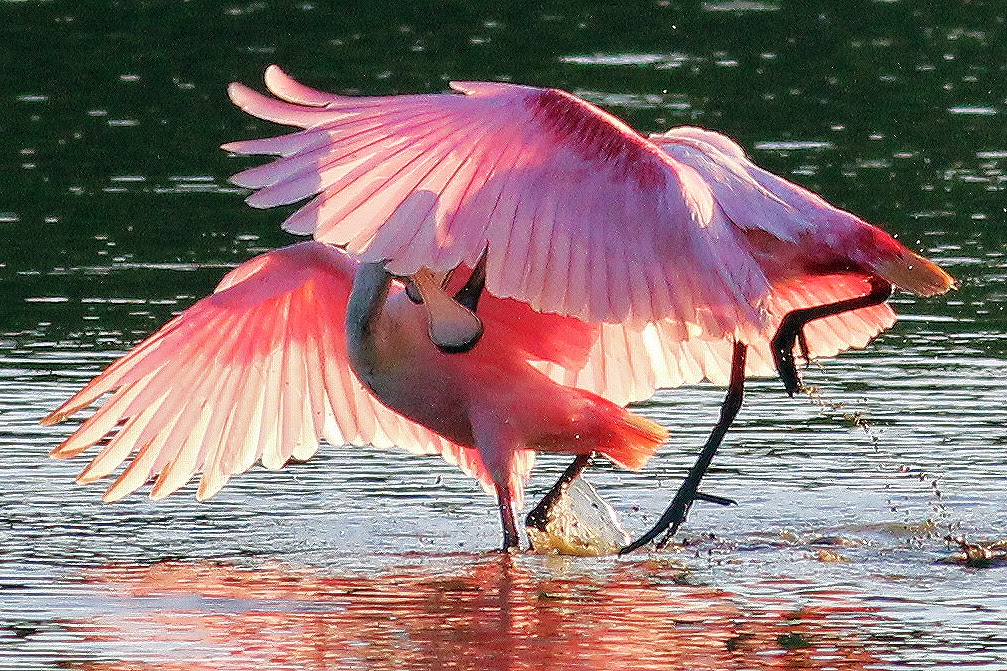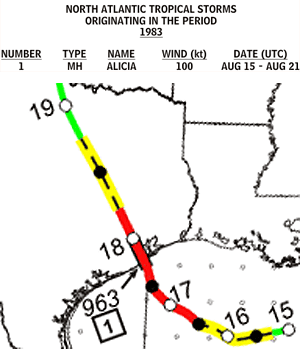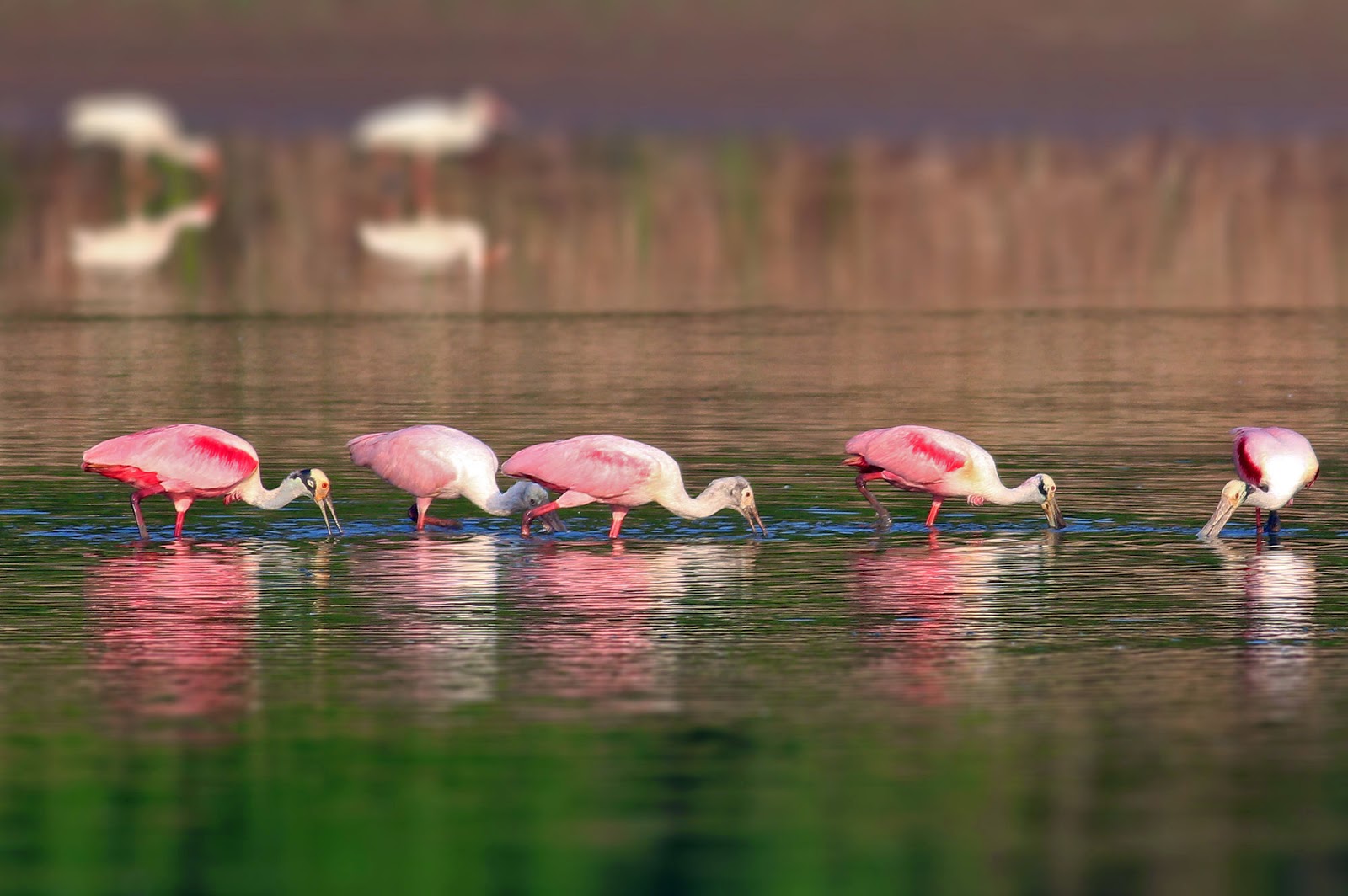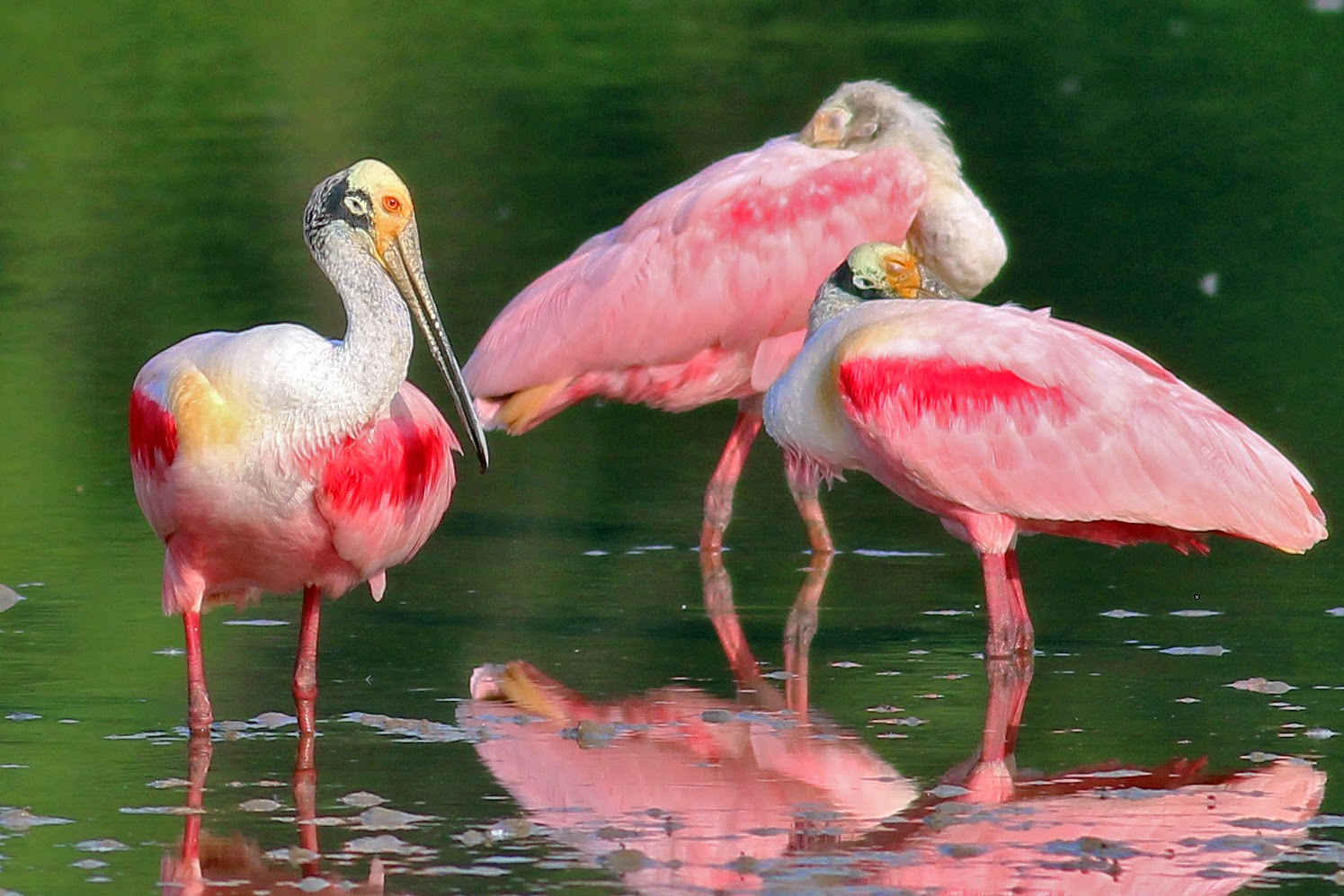Roseate Spoonbills Wild Passage To The Great Trinity Forest
 |
| The dance of the Roseate Spoonbills in the Great Trinity Forest Dallas, Texas Summer 2014 |
One can only imagine what this place must have looked like ten centuries ago when the Caddo danced on this very spot. The soil here is ancient. Holding profound human history and insight into the lives they lead, their environment and culture. It is the first Dallas, the ancient civilization that commanded this part of Texas for centuries.
For the most part, the land here remains as rugged, heavily timbered and green as it was when King Solomon ruled the Israelites. The charcoal remains of the Caddo cooking fires tell us so. The natural seeps of abundant sub-surface water still flow here across the soft sand and underlying limestone outcrops. No longer fit for human consumption but interesting none the less.
 |
| Wild Mustang Grapes by the bushel at Joppa Preserve |
The shelter and forage still found in the woods here could still support those human bands of yesteryear. The grapevines laden so heavy with fruit in July that the ground in many spots cannot be seen through all the fallen fruit. Vitis mustangensis the Mustang Grape is one of the most high climbing and heat tolerant varieties of grapes in the world. Disease resistant and bearing loads of fruit the grapes would be a real hit were they not so tart when raw.
Other more ready to eat fruit like the Purple Passion fruit can be found within arms reach.
 |
| Flowers of the Maypop Passion Fruit, Joppa Preserve July 2014 |
The plants Passiflora incarnata were given the name Passionflower or Passion vine because the floral parts were once said to represent aspects of the Christian crucifixion story, sometimes referred to as the Passion.
The 10 petal-like parts represents the disciples of Jesus, excluding Peter and Judas; the 5 stamens the wounds Jesus received; the knob-like stigmas the nails; the fringe the crown of thorns. The name Maypop comes from the hollow fruits that pop loudly when crushed.
 |
| Little Lemmon Lake and Roseate Spoonbills |
The Texans of old knew this place. Caddo hunters had waded the river here. The old South Dallas legend exists of Spanish searching for their city of gold and are thought to have dropped a battle axe in a creek within eyesight of this spot. Mexican and Anglo ox-men drove wagons this way. Freed slaves settled it and called it their own, a place called Joppa.
A newcomer expecting blight and a muddy river might be surprised by the diversity to be found here. A true melting pot of Texas nature at your feet. As one comes to appreciate the river here, the focus of nearly all those things one thinks of as truly Texan. A roadmap of twists and turns in the woods with surprises around every corner.
Few ever come to appreciate a place. A rare number have visited these places for many years. Then there is one, only one, known to me that is to have visited these spots for decades.
The Luminary, A Voice From The Woods — Father Timothy Gollob
 |
| Father Timothy Gollob discussing the call of the Indigo Bunting and keen insight on decades of Roseate Spoonbill observations, Joppa Preserve, Great Trinity Forest, Summer 2014 |
He was looking my way with a smile, pointing with his arm extended to smudges of pink on the far end of a lake. From a hundred yards away the lone man in black, crouched among head high cattails, armed with a pair of binoculars was espying Roseate Spoonbills. I knew I had found Father Timothy Gollob.
Here among the jagged, rough and steep terrain of the river bottoms walks a Catholic Priest. For nearly half a century Father Tim has explored the river here. Noting not just the ebb and flow of the river but the countless bird and animal species that abound here. His church and his rectory home, Holy Cross Catholic Church sits just up the road from the river at Bonnie View and Ledbetter.
 |
| Father Timothy Gollob watching Roseate Spoonbills through his binoculars at Joppa Preserve |
The Trinity River has served as Father Tim’s cageless aviary where he has documented decades of bird activity and sightings. His hundreds of reports and sightings rank him among the most prolific birders in Texas history, a true legend in many outdoor circles. His work as a man of God for a half century in South Dallas overshadows his bird study and fishing tales. A man who many regard as one of the great Texas humanitarians and cornerstones of a city which he calls home. If you don’t know him, you should.
 In the field, his graceful hand whittled narrated account of the land here and his description of bird sightings is a true treasure of knowledge. His accounts of the erstwhile Sleepy Hollow Golf Course turned lower chain of wetlands provides a great back story to this area before it became a civil engineering project.
In the field, his graceful hand whittled narrated account of the land here and his description of bird sightings is a true treasure of knowledge. His accounts of the erstwhile Sleepy Hollow Golf Course turned lower chain of wetlands provides a great back story to this area before it became a civil engineering project.
The stories of his sightings are weaved through Texas lore. Conversation that is very much that of the Deep South yet Southwestern. Something that is authentic Texan. His accent has a strong Texan flair to it, one decidedly North Texan in depth if there is still such a thing. Talk turns to the gravel pitted terrain of South Dallas County’s Sand Branch and Jordan Valley area. Travels across hard scrabble ranchland south of Dallas on fishing trips. It is the chat that describes the narrative mastery of the woods. A picture of the Trinity and North Texas in microcosm that is so rare to hear in such humble words.
 |
| Jeff Lane riding at Joppa Preserve |
Father Tim learned much of his birding craft from ornithologist and late University of Dallas Professor Warren M. Pulich. Pulich is considered the first resident professional ornithologist in North Texas. In the 1960s he authored the Birds of Tarrant County and later The Birds of North Central Texas. His groundbreaking work specialized in species like the rare Golden Cheeked Warbler. As Professor of Ornithology at the University of Dallas he led the way with many pioneering bird collection projects, many of which were from antenna strikes on local communication towers.
Often joining Father Tim is one of his parishoners, Jeff Lane, seen at right. Jeff’s family has owned a metal plating company just up the street for the last eighty years. He will pick up Father Tim at his church, drop him off at a starting spot and meet up miles on the other side of the woods.
Father Tim remarked that during a hurricane in 1983 that he observed Roseate Spoonbills off Loop 12 near I-45. He said that the birds appeared to have been storm blown to some extent maybe removed from the coast by the heavy winds and rain. I was able to look back through his bird reports, find the date and trace it to Hurricane Alicia which hit the west end of Galveston Island in August 1983.
The storm made a direct path up Trinity Bay and to Dallas where it hit much of North Texas with Tropical Storm and Tropical Depression winds and rain. An interesting observation on birds and weather.
Using the Trinity River Authority’s river data, this area sits on mile 463 of the Trinity River. A grand distance from where the freshwater of the Trinity meets that of the salty Gulf of Mexico.
Reconnoitering For Roseate Spoonbills
 |
| A solitary Snowy Egret joined by four Roseate Spoonbills at Little Lemmon Lake, Joppa Preserve, Dallas, Texas |
It is in the early evening, about when the sky goes to purple that Father Tim can be found on the river. The sky can appear enormous this time of day. The drone of rush hour dies away and the natural sounds of the woods take over the senses.
 |
| Heavy thunderstorm with pronounced anvil over Southern Dallas County as viewed from Little Lemmon Lake |
 |
| Roseate Spoonbill landing at Little Lemmon Lake |
Summer Saharan sands blowing in from Africa on the jet stream give the early summer of 2014 a pronounced rare shade of sky that is not often seen. A milky color of phosphorous tinged haze lingers over Dallas as a result.
Large storm cells often appear this time of year in the distance. Rarely do they make it into Dallas proper but provide a great background for photographing the sky. When the storms do come overhead the rain fires like bullets, chewing across the shallow water and into the tree canopy.
 |
| Changing light of an approaching storm mutes the light on the Roseate Spoonbills |
The pink specks of birds some hundred yards or more away presented a challenge for getting some good photographs. The ever widening stretches of cracking mud playa between the birds and the shore offer no cover to get close. The setting sun to the west would put the birds in unfavorable light.
The solution to the issue was to hit the heavy mangled overgrowth to the northwest of Little Lemmon Lake where lush and belt high poison ivy abounds. It is one of the old indestructible realities it seems of getting some good shots. Going places no one else would think of going. The high winds of approaching storms and the very dense poison ivy provided a great approach towards the ten foot high cattails that ring the shore. Here, smashed down in the reeds I was able to get closer than ever before to Roseate Spoonbills.
The being close part is not so important as it is the relaxed and natural state of the birds. The acts of capturing the preening, napping and natural behavior far exceed those of action photos of spooked birds in flight.
The real trick is getting in and back out again without your subject ever knowing you were ever there. Doing so, for a couple nights in a row allowed repeat visits to where the birds were wading and resting.
Spoonbills At Their Most Vibrant
 |
| Roseate Spoonbills preparing for an evening of feeding at Little Lemmon Lake |
 The Roseate Spoonbills plumage for 2014 is the most vibrant in color ever to be seen among Great Trinity Forest Spoonbills. Famed birders like Robert Porter Allen, likened the species to “orchids taking wing”.
The Roseate Spoonbills plumage for 2014 is the most vibrant in color ever to be seen among Great Trinity Forest Spoonbills. Famed birders like Robert Porter Allen, likened the species to “orchids taking wing”.
The absolute brilliant colors of orange, red, pink and red are offset under close review by a green hued head coloration only visible during breeding season. These are the apex of color in the North American bird world.
There are only two large pink hued birds in the United States, the Pink Flamingo and the Roseate Spoonbill. Natives of the sub-tropics, tropics and coastal areas, seeing either of the two species in the United States makes for a rare sight.
With a pink body and long, spatulate bill, the spoonbill is a marvel to behold. This coastal character even seems to wear a smile on its face.
Roseate Spoonbill Platalea ajaja
Roseate Spoonbills (Platalea ajaja) , which share the same pink plumage and long twiggy legs as flamingos, are actually members of the ibis family. Generally smaller than flamingos, Roseate Spoonbills grow to a height of 32 inches with a wingspan of 50 inches, have shorter necks, and longer, spoon-shaped bills.
The Roseate Spoonbill is typically a far southern bird of the Americas, breeding in Southern Mexico and Central America. In the United States it is typically found only along the far southern Gulf Coast. During summer and early fall the birds move inland searching for food and habitat along marshes and shallow ponds.
Uncommon in North Texas, Roseate Spoonbills can be seen infrequently in the shallow drying ponds and swamps in the Great Trinity Forest. Spoonbills are traditionally coastal birds and are a regular sight along the Texas Gulf Coast. Rare to see them hundreds of miles inland in not only a prairie but also a densely populated urban environment.
Hunted to near extinction in the early 1900s, the Roseate Spoonbill population dwindled to only 100 breeding pairs in Texas by the 1930s. Their striking pink feathers were popular on women’s hats and hunters from all over the United States competed for spoonbill plumes. Little did the buyers of such feathers know that the colors fade quite fast when removed from the bird.
Today, threats to Roseate Spoonbill populations come as a result of habitat loss. Even by 1979, their numbers had only rebounded to 2,500 birds in the wild. Currently their numbers have rebounded substantially enough to be removed from Federal protection as an Endangered and Threatened species.
Breeding populations are found along the south Florida coast from the Florida Keys north to St Joseph Bay, with some populations in northeastern Florida and along the coasts of Texas and Louisiana. The worldwide population is only 175,000 with 30,000 living in North America. Whittling down that number further, many of those 30,000 live in Florida, the Caribbean or along the Gulf Coast. It is estimated that there are 5,500 breeding pairs in the USA.
In Texas, the birds are still very much threatened as a population. The State of Texas is studying whether or not to declare Roseate Spoonbills as a state Threatened Species. This designation is a result of habitat loss and nesting areas across the state. In 2014 the farthest north in Texas a nest has been located is the Richland WMA southeast of Corsicana.
Pocket ponds and unnamed seldom visited waterbodies exist around the footprint of the future Byron Nelson Tournament site known as Trinity Forest Golf Club. These casual waterbodies called pulse inundated wetlands serve as vital habitat for many bird species. The shallow feeding areas of the Roseate Spoonbill is paramount to the species survival. Little Lemmon Lake and other pocket ponds and abandoned gravel quarries that dot this part of town serve as critical habitat for these wading birds.

A common theme in pulse-inundated wetlands are overbanking events from the flooding Trinity River.
The prey base like crawfish and minnows increase in abundance while the wetland is flooded and then become highly concentrated in deeper water refuges as water levels recede, becoming highly available to wading birds whose overall success depends on these concentrations.
The average lifespan of a Roseate Spoonbill in the wild is estimated at 28 years. During the course of its life a Spoonbill might have twenty solid breeding seasons and successfully raise young many of those years. It’s rather remarkable to let your mind wander that these birds come back year after year. I have been seeing them every year like clockwork since 2007. Same individual birds.
Video of Roseate Spoonbills at Joppa Preserve, Little Lemmon Lake
This was filmed at normal speed. The ability of the birds to filter feed through the water is astonishing.
Spoonbills consume a varied diet of small fish, amphibians, aquatic invertebrates, and some plant material. They feed in the early morning and evening hours by wading through shallow water with their bills partially submerged. As a Roseate Spoonbill walks it swings its head back and forth in a sideways motion. When the bird feels a prey item it snaps its bill closed, pulls the prey out of the water, and swallows it.
Here they are wading patiently in the shallows, nipping at fish, crawfish and snails with a long, rounded beak that gives them their name. With a super sensitive beak they can detect the smallest of watery prey.
It’s so very hard to express the rarity of wildlife movement through the Great Trinity Forest in Dallas or tell in words or pictures what is really there. What makes it a special place like no other in North Texas is hard to show. So many birds down there look alike, so many other animals are of a secretive nature where one only sees faint footprints rather than the creature itself.












